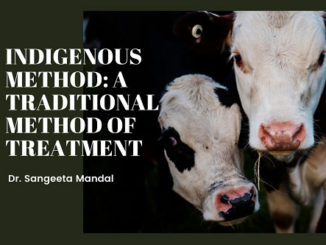Introduction
Reproductive performance is a measure of number of calf per cow per year. As a rule of thumb, a very good cow is a cow which produces one calf in every year. In many places, too often reproduction is at a low level, this can be concluded from the long calving intervals and low conception rates. The common reproductive problems are endometritis, anestrous, silent estrous, cystic ovarian degeneration, anovulation, retention of fetal membrane, uterine & vaginal prolapse, mummification, maceration, abortion, dystocia and other infections leads to reproduction failure in dairy cows.
Etiology
- Genetic makeup of animal and inbreeding and Improper herd management
- Lack of sufficient nutrition and Infectious diseases spread by venereal or other routes
- Improper handling of reproductive tract during artificial insemination or treatment
- Hormonal imbalance and Birth of abnormal calf and dystocia
- Poisoning by plant or chemicals
- Season of the year and Age of animal
- Presence of phyto-estrogen in the hilly region
- Rolling or fighting of animal in the hilly region
- Metabolic diseases, Disease of other systems and Heavy worm infestation
- Abnormal post partum disorder
- Abnormal parturition like cesarean section and fetotomy
- Improper administration of chemical drugs
Symptoms
- Animal coming to heat regularly but not conceived: repeat breeding syndrome
- Animal not at all showing estrus: anestrous
- Prolapse of vagina, uterus and cervix: hormonal imbalance & nutritional deficiency
- Hanging of mucus membrane after parturition or abortion: retained fetal membrane
- Presence of abnormal discharge or pus from the reproductive tract: endometritis and pyometra
- Presence of compact mass in per rectal examination: mummification
- In rectal palpation, the animal feels pain and uncomfortable: endometritis, metritis and uterine torsion
- Presence of reddish grey color discharge and bone fragments: maceration
- Temperature, pulse rate and respiration rate will be increased
- Completely lose of the appetite, lack of rumination, looking dull and depressed
- Animal is showing prolonged estrus: anovulation
- Tucked up of udder: uterine torsion
- Prolonged postpartum service interval, service period, number of service per conception, open days, calving interval and conception rate
- Edematous uterus, fetal membranes, milk fever, then coma, off feed, standing or sternal recumbence, weakness, depression, dried and hard or fresh uterine mass: uterine prolapse
- Septicemia in prolonged cases
- Early abortion (upto 4 months): Trichomoniasis and Vibriosis, late abortion (last trimester): brucellosis or any time: viral infections
Diagnosis
- History, Clinical signs
- Complete blood examination
- White side test: endometritis
- Antibiotic sensitivity test/ culture test of body fluid or discharge from the vagina
- Rectal examination and vaginal examination
- Hormonal assay
- Estimation of metabolites or mineral from blood or body fluids
- Analysis of plant extract for presence of poison or phyto estrogen
- Analysis of nutrient deficiency
- Presence of wide spread abortion or repeat breeding syndrome
- Presence of symptoms like restless movements, fever, loss of appetite, high pulse rate, heart rate and lack of rumination etc.
Prognosis
- Endometritis and metritis and pyometra: good to fair
- Cystic ovarian degeneration: fair to guarded
- Uterine and vaginal prolapse: good to fair in immediate case, poor to guarded: delayed cases
- Mummification: good to fair
- Maceration: poor to guarded
- Anestrus and anovulation: good to fair
- Dystocia, fetotomy, abnormal fetus: depending on the degree of case
- Uterine torsion: depending on the degree of case
Treatment
- Proper deworming the animals and Balanced nutrition
- Feed free from the poison, toxin and phyto estrogen
- Proper heat detection and artificial insemination
- Proper antibiotic treatment as per the ABST or culture test
- Anti-inflammatory therapy and supportive therapy like vitamins and minerals
- In anestrus, cystic ovarian degeneration, anovulation, delayed ovulation and repeat breeding syndrome: synchronization protocols
- Uterine, vaginal and cervical prolapse: reduce the prolapse and repair accordingly
- Maceration and mummification: prostaglandin therapy with antibiotic therapy
- Rectify the hormonal imbalance by proper injection of the necessary hormones
- Periodical vaccination in the endemic areas
- Pregnant animal always separated from the non-pregnant animals and bull
- Cull the genetically suffered and completely sterile animals
- Take proper precaution when handling the dystocia, fetotomy, retained fetal membrane and abortion
- Metabolic diseases should be treated as early as possible
- Uterine torsion case should be treated as quickly as possible
Control
- Ensure clean drinking water and protect the animal from any kind of stress
- Pregnant animals should not be allowed to mix other animals especially aborted or suffered any disease like brucellosis
- Animals should be kept away from slippery floor during advance pregnancy.
- 1-2 weeks before the expected date, pregnant animals should be separated from other animals
- Observe for signs of delivery: External genitalia swelling, udder swelling, restlessness and animals stand up and lie down frequently. Majority of the cows deliver without any help; in case, any calving difficulties, seek help of the veterinarian.
- External genitalia and flank should be cleaned after parturition and cow should be provided warm drinking water. The animal needs to be protected from chill especially during winter season.
- Normally placenta will be expelled within 2 to 6 hours of calving. If it is retained even after 8 hr of calving, take the help of a veterinarian.
- Placenta, mucus and uterine secretion should be cleaned thoroughly from the calf’s body and nose and the naval cord should be severed with a sterile knife followed by applicator of the iodine solution.
| The content of the articles are accurate and true to the best of the author’s knowledge. It is not meant to substitute for diagnosis, prognosis, treatment, prescription, or formal and individualized advice from a veterinary medical professional. Animals exhibiting signs and symptoms of distress should be seen by a veterinarian immediately. |









Be the first to comment